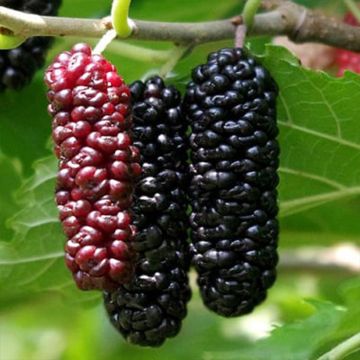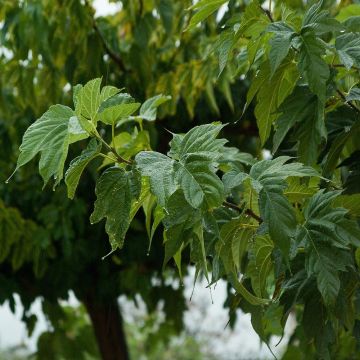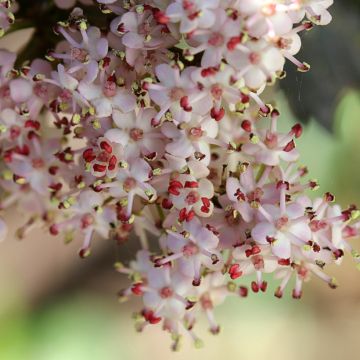

Morus kagayamae (bombycis) - Mûrier platane


Morus kagayamae (bombycis) - Mûrier platane


Morus kagayamae (bombycis) - Mûrier platane
Morus kagayamae - Mullberry
Morus kagayamae
White Mulberry, Russian Mulberry, Sycamine tree
Special offer!
Receive a €20 voucher for any order over €90 (excluding delivery costs, credit notes, and plastic-free options)!
1- Add your favorite plants to your cart.
2- Once you have reached €90, confirm your order (you can even choose the delivery date!).
3- As soon as your order is shipped, you will receive an email containing your voucher code, valid for 3 months (90 days).
Your voucher is unique and can only be used once, for any order with a minimum value of €20, excluding delivery costs.
Can be combined with other current offers, non-divisible and non-refundable.
Why not try an alternative variety in stock?
View all →This plant carries a 24 months recovery warranty
More information
We guarantee the quality of our plants for a full growing cycle, and will replace at our expense any plant that fails to recover under normal climatic and planting conditions.
Would this plant suit my garden?
Set up your Plantfit profile →
Description
Morus kagayamae, also known as the Plane Tree Mulberry, is a species with large deeply cut leaves that are dark green and turn golden yellow in autumn. This tree has a spreading habit, wider than it is tall when not pruned, and its dense foliage provides significant shade in summer. It is particularly appreciated as a shade tree in hot climates, as it resists drought well. It can be planted near the sea as it tolerates salt spray. In addition to its highly decorative foliage, it produces edible fruits in the form of mulberries, which have a sweet taste. Hardy, it enjoys full sun, or partial shade in hot regions, and grows well in ordinary, deep, and well-drained soil.
Morus kagayamae (syn. Morus bombycis) belongs to the Moraceae family, like fig trees (Ficus), Maclura, and Broussonetia. It is native to Southeast Asia, mainly Japan.
It grows quickly, initially with a slightly rounded habit, then spreading with age, reaching approximately 10m (33ft) wide and 8m (26ft) tall. In hot regions, it is often pruned horizontally, removing any poorly oriented branches to maximise its shade. It should be severely pruned each winter, removing a good portion of the new growth to maintain the main branches.
It has large leaves measuring 15 to 25cm (6 to 10in) long, deeply cut with a strongly acuminate central lobe. They vaguely resemble plane tree leaves, but they are dark green and shiny on top, while the underside is lighter. Highly decorative, they also turn yellow in autumn, and sometimes even at the beginning of winter as they fall late. In April-May, it produces inconspicuous catkins, which then develop into mulberry-like fruits. Starting off red, they turn black and are very sweet. They are appreciated by birds and pollinating insects. However, they can stain tiles or terrace paving when they fall on the ground. Morus kagayamae is moderately hardy, tolerating temperatures down to -12°C (10.4°F), or even -15°C (5°F) for older specimens. However, it is highly resistant to heat and drought once established. It also tolerates severe pruning and is well-suited to urban environments and paved soils, which explains its widespread presence in cities.
The Plane Tree Mulberry is a perfect tree for regions with hot summers, where strong shade is appreciated. It can be planted individually on a lawn in a natural form, without pruning, to enjoy its decorative foliage. Alternatively, it can be incorporated into a mixed border to provide shade for ferns such as Cyrtomium falcatum with its beautiful shiny dark green fronds, which will complement the mulberry leaves. Add some hellebores to enjoy their superb flowering in various colours, and also consider epimedium, a perennial that is not widely known despite its ornamental qualities and ease of cultivation. You will be captivated by the delicate flowers with their surprising shapes and the wide range of available colours.
Morus kagayamae - Mullberry in pictures




Plant habit
Flowering
Foliage
Botanical data
Morus
kagayamae
Moraceae
White Mulberry, Russian Mulberry, Sycamine tree
Southeast Asia
Other Morus - Mulberry
View all →Planting and care
Plant in spring in cooler areas, or in autumn in warm regions. Plant in well-drained, rather fertile and deep soil, that is not too chalky or too acidic. Position it in full sun. Be careful not to damage its roots during planting. It can tolerate moderately cold temperatures down to -12 to -15 °C (10.4 to 5°F) at its coldest for mature specimens, and it also withstands drought once well rooted. It is well suited for coastal areas as it tolerates sea spray well.
It is widely planted as a shade tree due to its spreading habit and large leaves. In this usage, it is usually pruned every winter to maintain its shape and limit its growth.
Planting period
Intended location
Care
Planting & care advice
This item has not been reviewed yet - be the first to leave a review about it.
Similar products
Haven't found what you were looking for?
Hardiness is the lowest winter temperature a plant can endure without suffering serious damage or even dying. However, hardiness is affected by location (a sheltered area, such as a patio), protection (winter cover) and soil type (hardiness is improved by well-drained soil).

Photo Sharing Terms & Conditions
In order to encourage gardeners to interact and share their experiences, Promesse de fleurs offers various media enabling content to be uploaded onto its Site - in particular via the ‘Photo sharing’ module.
The User agrees to refrain from:
- Posting any content that is illegal, prejudicial, insulting, racist, inciteful to hatred, revisionist, contrary to public decency, that infringes on privacy or on the privacy rights of third parties, in particular the publicity rights of persons and goods, intellectual property rights, or the right to privacy.
- Submitting content on behalf of a third party;
- Impersonate the identity of a third party and/or publish any personal information about a third party;
In general, the User undertakes to refrain from any unethical behaviour.
All Content (in particular text, comments, files, images, photos, videos, creative works, etc.), which may be subject to property or intellectual property rights, image or other private rights, shall remain the property of the User, subject to the limited rights granted by the terms of the licence granted by Promesse de fleurs as stated below. Users are at liberty to publish or not to publish such Content on the Site, notably via the ‘Photo Sharing’ facility, and accept that this Content shall be made public and freely accessible, notably on the Internet.
Users further acknowledge, undertake to have ,and guarantee that they hold all necessary rights and permissions to publish such material on the Site, in particular with regard to the legislation in force pertaining to any privacy, property, intellectual property, image, or contractual rights, or rights of any other nature. By publishing such Content on the Site, Users acknowledge accepting full liability as publishers of the Content within the meaning of the law, and grant Promesse de fleurs, free of charge, an inclusive, worldwide licence for the said Content for the entire duration of its publication, including all reproduction, representation, up/downloading, displaying, performing, transmission, and storage rights.
Users also grant permission for their name to be linked to the Content and accept that this link may not always be made available.
By engaging in posting material, Users consent to their Content becoming automatically accessible on the Internet, in particular on other sites and/or blogs and/or web pages of the Promesse de fleurs site, including in particular social pages and the Promesse de fleurs catalogue.
Users may secure the removal of entrusted content free of charge by issuing a simple request via our contact form.
The flowering period indicated on our website applies to countries and regions located in USDA zone 8 (France, the United Kingdom, Ireland, the Netherlands, etc.)
It will vary according to where you live:
- In zones 9 to 10 (Italy, Spain, Greece, etc.), flowering will occur about 2 to 4 weeks earlier.
- In zones 6 to 7 (Germany, Poland, Slovenia, and lower mountainous regions), flowering will be delayed by 2 to 3 weeks.
- In zone 5 (Central Europe, Scandinavia), blooming will be delayed by 3 to 5 weeks.
In temperate climates, pruning of spring-flowering shrubs (forsythia, spireas, etc.) should be done just after flowering.
Pruning of summer-flowering shrubs (Indian Lilac, Perovskia, etc.) can be done in winter or spring.
In cold regions as well as with frost-sensitive plants, avoid pruning too early when severe frosts may still occur.
The planting period indicated on our website applies to countries and regions located in USDA zone 8 (France, United Kingdom, Ireland, Netherlands).
It will vary according to where you live:
- In Mediterranean zones (Marseille, Madrid, Milan, etc.), autumn and winter are the best planting periods.
- In continental zones (Strasbourg, Munich, Vienna, etc.), delay planting by 2 to 3 weeks in spring and bring it forward by 2 to 4 weeks in autumn.
- In mountainous regions (the Alps, Pyrenees, Carpathians, etc.), it is best to plant in late spring (May-June) or late summer (August-September).
The harvesting period indicated on our website applies to countries and regions in USDA zone 8 (France, England, Ireland, the Netherlands).
In colder areas (Scandinavia, Poland, Austria...) fruit and vegetable harvests are likely to be delayed by 3-4 weeks.
In warmer areas (Italy, Spain, Greece, etc.), harvesting will probably take place earlier, depending on weather conditions.
The sowing periods indicated on our website apply to countries and regions within USDA Zone 8 (France, UK, Ireland, Netherlands).
In colder areas (Scandinavia, Poland, Austria...), delay any outdoor sowing by 3-4 weeks, or sow under glass.
In warmer climes (Italy, Spain, Greece, etc.), bring outdoor sowing forward by a few weeks.




























































